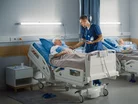How smart ‘eyes’ & video can benefit patient healthcare

This year, the NHS is facing some of its most critical pressures yet in its 75th year; from demand increasing this winter with the onset of cold weather and flu, to chronic staff shortages currently standing at around 132,000 in NHS trusts and 165,000 in social care.
A sea change is needed in how operations are handled in the NHS. Advancements in efficiency, finding value-adds, and improving patient outcomes are vital. Video, long seen as simply a way to improve security, is coming to the forefront as a key enabler of this.
Operation management in healthcare
With the right video platform investments, NHS leaders can gather crucial insights on building use, patient care and wellbeing, queue and occupancy management, face mask wearing/social distancing, and more. Key to this is having an open video management system (VMS) that can easily integrate with existing legacy systems and new technologies, bringing together the benefits of video, analytics, the Internet of Things (IoT), access control, and perimeter control.
Yet, many healthcare facilities remain stuck with video surveillance only as a security tool. Over half (54%) of healthcare organisations currently have camera installations that aren’t connected to other systems. Over two-thirds (69%) of organisations have plans to connect their video technology with additional technologies in the next 24 months. Right now, organisations are using video technology for access control and security checks, but plan to move towards real-time inventory, queue management, clinical collaboration, patient assistance, smart surgery and immersive medical training.
Supporting collaboration and information sharing across the healthcare sector
An open platform aligns with the NHS Long-Term Plan, specifically the aim to ensure ‘systems talk to each other and share vital information to support the delivery of care’. Open systems are flexible, allowing each Trust or Healthcare Provider to choose options that work best. It integrates with existing systems as well as new ones, so legacy infrastructure can be updated in stages. Collaboration between different agencies and stakeholders is improved with the open VMS consolidating and surfacing all the key information needed to make decisions.
As an additional benefit of this, having everything in one place avoids duplication of resources and efforts - a considerable plus in today’s resource-strapped climate.
Improving efficiency and patient monitoring with video technology in healthcare
Advanced use of video technology means that staff efficiency is also improved; the monitoring of just one platform is needed, and staff will see everything happening on the ground across a hospital site.
Automation and video analytics enabled by the VMS do a lot of the heavy lifting when it comes to continuous monitoring. Security teams can focus on other tasks with the peace of mind that the VMS will alert them to anything that requires their input.
This extends to healthcare staff too and can be an attractive feature for teams grappling with staff shortages. Video analytics can alert healthcare professionals of any patients on a ward who need assistance, for example, if they have fallen or lost their way walking through the hospital.
Remote patient monitoring carried out by a VMS can support Trusts in providing high-quality patient care and reacting to incidents quickly. Because automation is continuously monitoring, this ensures care remains consistently proactive, 24/7, without being impacted by staff or operator fatigue.
Neil Killick, EMEA Sales Director of Developed Markets, Milestone Systems
Understanding building use
Data collected from cameras, heating, air-con and ventilation (HVAC), and other connected sensors, can be used to understand how people (patients, visitors, and staff) move through and use a building. It can quickly identify any crowds, queues, or bottlenecks forming, so staff can take mitigating action to either disperse a crowd or open additional routes and receptions to reduce bottlenecks. Longer term, this information can shape how a site is designed, to improve the experience of attending a clinic or hospital. It can also influence staff rotas or cleaning and maintenance schedules, with more heavily used areas given more regular attention.
Energy savings can also be made — for example, when integrated with an HVAC system or lighting controls, heating and lights can automatically switch on and off when the VMS detects people entering and exiting a space. Integration with digital signage can help with patient wayfinding.
Preparing for the future of healthcare
Part of the NHS Long-Term Plan is to continue developing its IT systems - which requires healthcare leaders to be ahead of new developments in technology, including the responsible use of artificial intelligence (AI), the IoT, and smart cities. With an open VMS, leaders have the freedom to experiment with new technologies that will improve efficiency and patient outcomes. They also have the flexibility to pick the best options that work for their organisations, staff, and patients.
Doing more for patients
There’s a lot more to modern video technology than just reacting to security incidents. Investing in an intelligent video platform will enable healthcare facilities to do so much more; improving patient care and monitoring, alongside operational efficiencies, response times, and the overall experience of visiting a clinic or hospital. As the NHS goes into yet another challenging winter, consider the role that technology plays in easing pressures on the service.
Written by Neil Killick, EMEA Sales Director of Developed Markets, Milestone Systems



